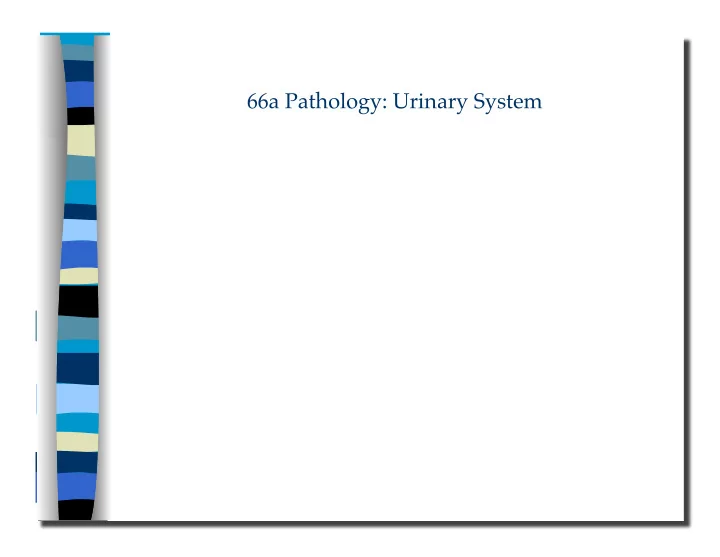

66a Pathology: Urinary System �
66a Pathology: Urinary System � Class Outline � 5 minutes � � Attendance, Breath of Arrival, and Reminders � 10 minutes � Lecture: � 25 minutes � Lecture: � 15 minutes � Active study skills: � 60 minutes � Total �
66a Pathology: Urinary System � Class Reminders �
Classroom Rules � Punctuality - everybody’s time is precious � Be ready to learn at the start of class; we’ll have you out of here on time � � Tardiness: arriving late, returning late after breaks, leaving during class, leaving � early � The following are not allowed: � Bare feet � � Side talking � � Lying down � � Inappropriate clothing � � Food or drink except water � � Phones that are visible in the classroom, bathrooms, or internship � � You will receive one verbal warning, then you’ll have to leave the room. �
66a Pathology: Urinary System � Packet E - 169 �
Kidney Disorders Kidney stones � Renal failure �
Kidney Disorders Kidney stones (AKA: renal calculi or nephrolithiases) Solid deposits of crystalline substances in the kidney, usually due to inadequate fluid intake. May pass through unnoticed, or may cause extreme pain – sudden onset, often referring to the groin area - if they get stuck or scrape the lining of the urinary tract. �
Kidney Disorders Calcium stones Most common kidney stone type. Composed of calcium. Associated with problems with calcium metabolism or too much incoming calcium such as supplements or antacids. � Struvite stones Composed of magnesium and ammonia. Associated with chronic urinary tract infections (UTIs). � Uric acid stones Associated with a diet high in meat and purines. Blood has abnormally high acidity. High risk for gout. � Cystine stones Relatively rare. Related to a genetic dysfunction with metabolism of an amino acid called cystine. �
Kidney Stones
Kidney Disorders Renal failure Inability of the kidneys to function at normal levels. Symptoms affect nearly every major organ system and include reduced urine output, systemic edema, and changes in mental state brought about by the accumulation of toxins in the blood. �
Bladder and Urinary Tract Disorders Interstitial cystitis � Urinary tract infection �
Bladder and Urinary Tract Disorders � Interstitial cystitis Chronic irritation and inelasticity of the bladder, caused by failure of inner lining to protect bladder from acidity. Causes chronic pelvic pain and painful urination, with symptoms worse when bladder is full. �
Bladder and Urinary Tract Disorders � Urinary tract infection Infection caused by bacteria that live harmlessly in the digestive tract finding their way into the urinary tract. Symptoms include painful, burning urination, as well as possibly pain in the pelvic, abdominal or low back areas. �
66a Pathology: Urinary System �
Recommend
More recommend